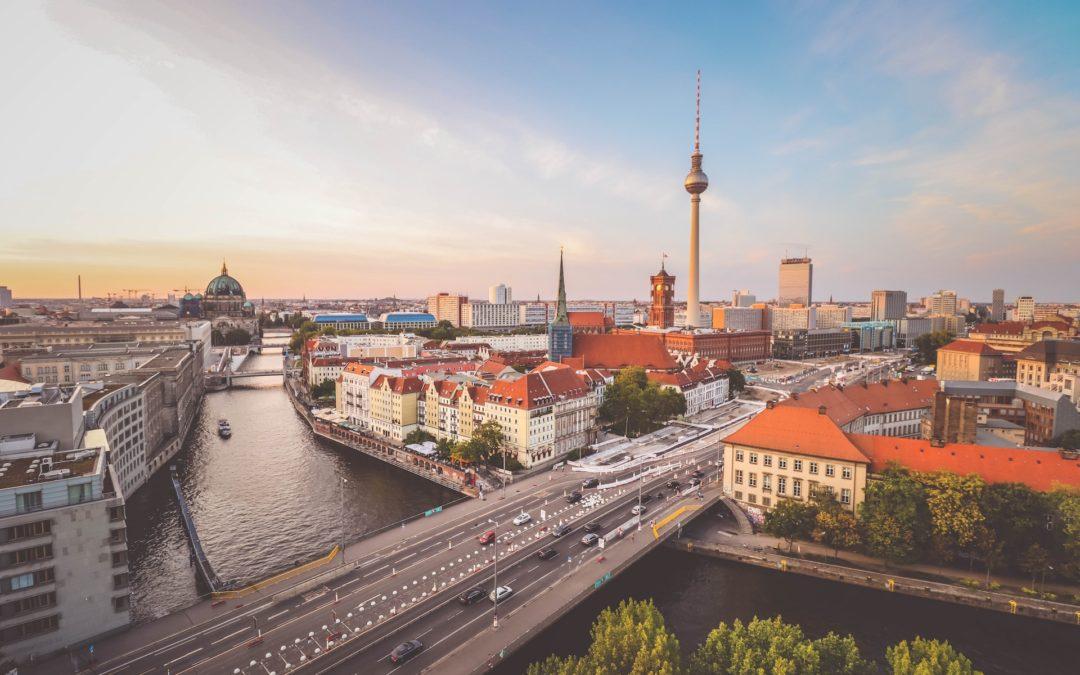Welcome to Berlin, the vibrant capital of Germany where rich history blends seamlessly with modern innovation, creating a truly unique and dynamic city. From its iconic landmarks and cultural diversity to its thriving arts scene and buzzing nightlife, Berlin offers an unparalleled experience for those fortunate enough to call it home. In this comprehensive guide, we will delve into the essence of Berlin’s lifestyle, unveiling ten intriguing facts that shed light on what it is truly like to live in this captivating metropolis.
Berlin: A Vibrant and Diverse City
Berlin, the capital of Germany, has long been renowned for its vibrant and diverse character. This city effortlessly blends a rich historical past with a thriving contemporary culture, creating a unique atmosphere that draws in people from all over the world. As you step foot onto its bustling streets, you’ll quickly realize that Berlin is much more than just a city—it’s a living, breathing entity that constantly evolves and embraces change.
With a population exceeding 3.7 million people, Berlin stands as Germany’s largest city and offers an abundance of opportunities and experiences for its residents. Its reputation as a hub for creativity, innovation, and artistic expression has attracted countless individuals, making it a true melting pot of cultures, ideas, and perspectives. Whether you’re an artist seeking inspiration, a history enthusiast eager to explore the past, or a food lover in search of culinary delights, Berlin promises an immersive experience like no other.
Historical Background
Berlin, the vibrant and dynamic capital of Germany, holds immense historical significance. With a rich past that stretches back centuries, Berlin has been a witness to pivotal moments in European history. As the capital, it serves as the political and administrative hub of the country, representing its cultural and economic prowess.
World War II had a profound impact on Berlin, leaving scars that can still be seen today. The city experienced extensive destruction during the war, with iconic landmarks reduced to rubble. Furthermore, the conflict led to the division of Berlin, both physically and ideologically, during the Cold War. The construction of the Berlin Wall in 1961 separated families, friends, and communities, becoming a symbol of the East-West divide.
The fall of the Berlin Wall in 1989 marked a pivotal moment in history, symbolizing the reunification of East and West Germany. Following this historic event, Berlin underwent a remarkable transformation into a vibrant cultural hub. The city embraced its newfound unity and became a melting pot of creativity, attracting artists, musicians, and intellectuals from around the world. Today, Berlin stands as a testament to the resilience of its people and the power of cultural exchange.
Cultural Diversity
Berlin’s allure lies in its multicultural fabric, making it a true melting pot of diverse cultures and nationalities. People from all corners of the world have made Berlin their home, bringing with them their unique traditions, languages, and perspectives. This cultural tapestry has enriched the city’s social fabric and contributed to its reputation as a cosmopolitan destination.
Berlin owes much of its culinary delights, vibrant festivals, and thriving art scene to its immigrant communities. The city’s diverse neighborhoods boast a range of international cuisines, from traditional Turkish döner kebabs to Vietnamese pho and Ethiopian injera. These flavors merge and mingle, offering a culinary journey that reflects Berlin’s multicultural essence.
Moreover, immigrant communities have infused the city with their vibrant traditions, contributing to a rich tapestry of festivals and events. From the Turkish community’s vibrant street market, the Turkish Market along the canal in Kreuzberg, to the annual Thai New Year celebration, Songkran, Berlin embraces and celebrates the cultural heritage of its residents.
One of the most spectacular manifestations of Berlin’s cultural diversity is the Karneval der Kulturen (Carnival of Cultures). This vibrant festival takes place annually and attracts hundreds of thousands of visitors from all over the world. The Karneval der Kulturen showcases a dazzling array of music, dance, costumes, and culinary delights, representing the city’s multicultural spirit. It provides a platform for various communities to express their traditions, fostering a sense of unity and celebrating the richness of Berlin’s diversity.
Living in Berlin means immersing oneself in a city that has been shaped by its historical significance, transformed by the winds of change, and infused with the beauty of cultural diversity. It is an ever-evolving metropolis that embraces its past while forging a path toward a vibrant and inclusive future.
Neighborhoods and Districts of Berlin
Berlin is a city renowned for its vibrant and diverse neighborhoods, each with its own distinct character and charm. Let’s explore some of the most popular ones:
- Mitte: Located in the heart of the city, Mitte is Berlin’s central district and home to many iconic landmarks such as the Brandenburg Gate and Museum Island. It combines history with modernity, boasting a mix of elegant boulevards, trendy cafes, art galleries, and high-end boutiques.
- Kreuzberg: Known for its alternative and multicultural atmosphere, Kreuzberg is a vibrant neighborhood that has become a hub for artists, musicians, and young creatives. Here, you’ll find a plethora of street art, bustling markets, quirky shops, and a lively nightlife scene.
- Prenzlauer Berg: This neighborhood has undergone significant transformation in recent years. Prenzlauer Berg is now a trendy and family-friendly area, characterized by its beautiful tree-lined streets, cozy cafes, organic food markets, and a plethora of playgrounds. It has a relaxed and bohemian vibe that attracts both locals and visitors alike.
- Friedrichshain: Known for its youthful energy and alternative culture, Friedrichshain is a neighborhood that never sleeps. It offers a mix of trendy bars, underground clubs, and vibrant street life. The neighborhood is also home to the East Side Gallery, a section of the Berlin Wall covered in stunning murals.
Unique characteristics and vibes of each neighborhood
Each neighborhood in Berlin has its own unique characteristics and vibes, catering to different lifestyles and preferences:
- Mitte offers a blend of history and modernity, with a sophisticated and cosmopolitan atmosphere.
- Kreuzberg embraces its multicultural roots, showcasing a rebellious and creative spirit that’s reflected in its street art, music venues, and diverse culinary scene.
- Prenzlauer Berg exudes a laid-back and family-friendly ambiance, with its beautiful parks, charming cafes, and a strong sense of community.
- Friedrichshain attracts the younger crowd, with its edgy and alternative vibe, energetic nightlife, and an abundance of cultural events.
Berlin offers a diverse range of housing options to cater to different tastes and budgets. Whether you prefer the sleek lines of modern architecture or the charm of historic buildings, you’ll find something to suit your preferences.
In recent years, modern apartment complexes have been springing up across the city, offering state-of-the-art amenities and contemporary designs. These apartments often come with communal spaces, such as rooftop gardens or fitness centers, fostering a sense of community.
For those seeking a taste of history, there are numerous beautifully restored buildings that retain their original architectural features. From elegant Altbau apartments with high ceilings and ornate detailing to charming courtyards nestled within Gründerzeit houses, Berlin’s historic housing options are full of character.
Additionally, Berlin also has a thriving rental market, which provides a range of options for those looking to experience the city’s vibrant atmosphere without committing to long-term ownership.
Below you can find a very interesting and detailed comparison of Berlin’s most important districts and their characteristics and proc and cons.
Public Transportation in Berlin
Ttrams, buses, and bicycles
Berlin boasts an efficient and well-connected public transportation system, making it easy to navigate the city without a car. The extensive network includes trains (S-Bahn and U-Bahn), trams, buses, and bicycles.
The S-Bahn and U-Bahn trains are the backbone of Berlin’s transportation system, providing fast and reliable connections throughout the city and beyond. The trams, with their iconic yellow carriages, offer a charming and scenic way to explore different neighborhoods. Buses complement the rail network, ensuring comprehensive coverage even in areas not served by trains or trams.
Cycling is also highly popular in Berlin, thanks to the city’s extensive network of bike lanes and a bike-sharing system. With flat terrain and a bike-friendly culture, many residents choose to commute by bicycle, enjoying the freedom and convenience it offers.
Berlin’s WelcomeCard and its benefits
The Berlin WelcomeCard is a valuable companion for both residents and tourists. This card offers unlimited access to Berlin’s public transportation system, including trains, trams, and buses, within specific zones. It also provides discounts and special offers for various attractions, museums, and restaurants across the city.
For tourists, the Berlin WelcomeCard is an excellent way to explore the city and make the most of their visit, as it allows unlimited travel and helps save on transportation costs. Residents can also benefit from this card by enjoying discounted admission to cultural sites and convenient travel options throughout their everyday lives. You can read more about the WelcomeCard here berlin-welcomecard.de.
Berlin is renowned for its excellent public transportation infrastructure, which ensures easy accessibility and convenience for residents and visitors, even without a car. The comprehensive network of trains, trams, and buses covers the entire city, making it simple to reach any destination.
The frequency and reliability of public transportation services are exceptional, with trains and trams operating at regular intervals throughout the day and night. This makes it convenient to travel at any time, whether for work, leisure, or exploring the city’s vibrant nightlife.
Moreover, Berlin’s compact layout and well-planned transportation system mean that many daily amenities, such as supermarkets, parks, and cultural attractions, are within walking or cycling distance. This pedestrian-friendly environment encourages a healthy and sustainable lifestyle while reducing the need for car usage.
Overall, living in Berlin without a car is not only feasible but also enjoyable, thanks to the city’s efficient public transportation system and the abundance of alternative travel options.
Green Spaces and Recreation
Berlin is a city that prides itself on its abundant green spaces, providing residents with ample opportunities to connect with nature and enjoy outdoor activities. With a remarkable number of parks, gardens, and lakes scattered throughout the city, Berlin truly offers a haven for nature lovers and outdoor enthusiasts.
Famous parks in Berlin
- Tiergarten: As one of the largest urban parks in Europe, Tiergarten is a beloved retreat for locals and visitors alike. Its vast green expanse provides a tranquil escape from the bustling city, offering opportunities for jogging, biking, or leisurely strolls. Within the park, you’ll find picturesque lakes, charming cafes, and even the iconic Brandenburg Gate.
- Tempelhofer Feld: Once an airport, Tempelhofer Feld has been transformed into an expansive recreational area that spans over 300 hectares. The open fields and runways now serve as a playground for various outdoor activities such as kite flying, skateboarding, and rollerblading. It’s also a popular spot for picnics and barbecues during the warmer months.
- Mauerpark: Nestled in the vibrant neighborhood of Prenzlauer Berg, Mauerpark offers a unique blend of greenery and cultural experiences. On Sundays, the park comes alive with the famous Mauerpark Flohmarkt (flea market) where visitors can browse through vintage treasures and enjoy live music performances. Additionally, the park’s hilltop amphitheater hosts karaoke sessions, drawing crowds of enthusiastic participants and spectators.
In addition to the well-known parks mentioned above, Berlin offers a wide array of opportunities for outdoor activities, sports, and relaxation. The city’s extensive network of bike lanes and paths make it a paradise for cyclists, allowing residents to effortlessly explore various neighborhoods and discover hidden gems.
For water enthusiasts, Berlin’s lakes provide idyllic settings for swimming, sunbathing, and even water sports such as canoeing and paddleboarding. Popular lakes like Müggelsee, Schlachtensee, and Wannsee are easily accessible and offer a refreshing retreat from the urban landscape.
Furthermore, Berlin’s green spaces are not limited to traditional parks. The city boasts numerous community gardens and urban farming initiatives, where residents can get involved in sustainable practices and reconnect with the earth.
Whether you prefer to engage in team sports at one of Berlin’s many sports clubs, practice yoga in the park, or simply unwind with a book under the shade of a tree, the city offers an abundance of options for relaxation and outdoor recreation.
Arts and Culture
Berlin’s vibrant art scene is a testament to its status as a global cultural hub. The city is home to an impressive array of galleries and museums that showcase works ranging from classical to contemporary art. From the world-renowned Museum Island, housing five prominent museums, to the innovative and experimental spaces of the East Side Gallery, Berlin offers a diverse and enriching art experience for every taste.
Additionally, the streets of Berlin serve as a living canvas for countless talented street artists. You’ll find captivating murals and thought-provoking graffiti adorning the city’s walls, particularly in neighborhoods like Kreuzberg and Friedrichshain.
Berlin’s cultural landscape is enriched by its esteemed institutions, such as the Berlin Philharmonic and the Berlin State Opera. The Berlin Philharmonic, renowned for its exceptional acoustics and world-class performances, is a magnet for music lovers from around the globe. The Berlin State Opera, with its rich history and stunning architecture, presents an impressive repertoire of operas and ballets, showcasing the talent of both established and emerging artists.
The performing arts scene in Berlin is vibrant and diverse, offering an extensive selection of theater productions, musicals, and concerts. The city is home to a multitude of theaters, including the iconic Berliner Ensemble and the Deutsches Theater, which stage performances ranging from classical plays to avant-garde productions.
Music enthusiasts can indulge in a wide range of genres, from classical symphonies at the Konzerthaus Berlin to underground electronic music in renowned clubs like Berghain and Watergate.
Furthermore, Berlin hosts one of the most prestigious film festivals in the world, the Berlinale. This annual event attracts filmmakers, industry professionals, and film enthusiasts who gather to celebrate the art of cinema and discover groundbreaking works from around the globe.
Living in Berlin means immersing yourself in a thriving arts and culture scene, where creativity knows no bounds and inspiration awaits at every corner.
Nightlife and Entertainment
Bars, clubs, and music venues in Berlin
Berlin is renowned for its vibrant and diverse nightlife, making it a haven for those seeking memorable evenings out. The city’s nightlife scene is incredibly dynamic, with a wide range of options catering to various tastes and preferences.
When it comes to bars, Berlin has something for everyone. From trendy cocktail lounges to cozy neighborhood pubs, you’ll find a plethora of establishments where you can unwind and enjoy a drink. The city is also home to numerous craft beer bars, where beer enthusiasts can indulge in a wide selection of local and international brews.
For those looking to dance the night away, Berlin’s clubbing scene is legendary. The city boasts world-famous clubs that have become synonymous with electronic music, drawing in crowds from all over the globe. These clubs often host renowned DJs and offer unique experiences with their innovative sound systems and immersive environments.
Music lovers will also appreciate the abundance of live music venues in Berlin. From intimate jazz clubs to larger concert halls, there are countless opportunities to catch performances by both established and up-and-coming artists across various genres.
Theaters, cinemas, and comedy clubs in Berlin
Beyond its thriving nightlife, Berlin offers a wide array of entertainment options to suit all interests. The city is home to numerous theaters, showcasing a diverse range of performances, including plays, musicals, ballets, and operas. Whether you prefer classic productions or experimental avant-garde shows, you’ll find a theater that caters to your taste.
Cinema enthusiasts will also find plenty to indulge in, with a plethora of cinemas screening everything from mainstream blockbusters to independent and arthouse films. Berlin hosts several film festivals throughout the year, attracting both industry professionals and movie enthusiasts alike.
For those in search of laughter, Berlin’s comedy scene is sure to delight. The city boasts a range of comedy clubs and venues that regularly host stand-up shows and improv performances. You can expect a mix of local talent and international comedians, ensuring a good dose of laughter for all.
Berlin – the city that never sleeps
One of the most remarkable aspects of living in Berlin is the city’s reputation as a place that never sleeps. No matter the time of day or night, there’s always something happening in Berlin.
From late-night shopping at convenience stores to 24-hour bakeries, Berlin ensures that you can fulfill your needs and desires around the clock. The city’s vibrant atmosphere extends beyond the weekends, with weekdays offering a plethora of events and activities.
Whether you’re an early bird seeking morning yoga sessions in the park, an art enthusiast exploring galleries late into the night, or a night owl enjoying the pulsating energy of the city’s clubs, Berlin caters to a wide range of lifestyles.
Moreover, Berlin’s multicultural nature contributes to its diverse and inclusive character. The city embraces people from all walks of life, fostering an environment where everyone can find their niche and express their individuality freely. This inclusivity extends to the nightlife and entertainment scene, ensuring that there’s something for everyone, regardless of their tastes or preferences.
Living in Berlin means being part of a city that embraces the concept of “live and let live.” It’s an exhilarating experience where you can explore the city’s countless offerings and create memories that will last a lifetime. Berlin truly epitomizes the notion of a city that never sleeps, continuously reinventing itself to keep residents and visitors alike entertained, inspired, and fulfilled.
Food and Dining
When it comes to food and dining, Berlin is a vibrant and diverse city that caters to all tastes and preferences. The culinary scene here is a beautiful amalgamation of traditional German cuisine and an array of international flavors. Whether you’re a fan of hearty German sausages and schnitzels or crave exotic dishes from around the world, Berlin has something to satisfy every palate.
Berlin boasts a rich culinary heritage with several iconic food specialties that are must-try experiences for residents and visitors alike. Currywurst, a delicious combination of a grilled sausage smothered in curry ketchup and sprinkled with curry powder, is a beloved street food that originated in the city. Doner kebabs, introduced by the Turkish community, have also become a staple street food item and a quick and tasty option for a meal on the go.
To truly immerse yourself in the local food culture, make sure to visit Berlin’s bustling street food markets. The Markthalle Neun in Kreuzberg is a popular destination where you can explore a wide range of culinary delights. From freshly baked bread and pastries to gourmet cheeses and regional produce, this vibrant market offers a feast for the senses. Another noteworthy location is the Street Food Thursday at Markthalle Neun, where you can indulge in a variety of international cuisines served up by local vendors.
In recent years, Berlin has witnessed a remarkable rise in the availability and popularity of vegetarian, vegan, and organic food options. The city has embraced the concept of sustainable and ethical dining, making it a paradise for those with dietary preferences or restrictions.
Vegetarian and vegan restaurants have flourished throughout Berlin, offering innovative and mouthwatering plant-based dishes that cater to all tastes. Whether you’re in the mood for a flavorful vegan burger, a delectable plant-based sushi roll, or a hearty vegetarian curry, you’ll find a wide range of options to satisfy your cravings.
Moreover, Berlin is home to numerous organic food markets and stores, where you can find locally sourced, pesticide-free produce and environmentally friendly products. These markets promote a farm-to-table approach, connecting consumers with the freshest ingredients and supporting sustainable farming practices.
Living in Berlin means embracing a culinary scene that is constantly evolving and catering to the diverse tastes of its residents. From traditional German delicacies to a wide range of international cuisines, and from vegetarian and vegan options to the availability of organic and sustainable food, Berlin truly offers a delightful and inclusive dining experience for everyone.
Overview of Berlin’s Cost of Living
When it comes to affordable cost of living, Berlin stands out as a favorable option among major European cities. The German capital offers a unique combination of reasonable expenses and a high standard of living, making it an attractive destination for those seeking a balance between quality of life and budget considerations.
Compared to other metropolises like Paris, London, or Zurich, Berlin often emerges as a more cost-effective choice. Housing, in particular, presents a significant advantage in Berlin. Rental prices for apartments and houses are generally lower compared to other European capitals, allowing residents to find spacious and comfortable accommodations at a reasonable cost. Additionally, the city’s diverse neighborhoods cater to various lifestyles and preferences, offering options that suit different budgets.
Estimation of Average Costs of Living in Berlin:
To provide a better understanding of the average costs of living in Berlin, let’s take a closer look at some key aspects. Please note that these figures are approximations and can vary depending on individual circumstances and lifestyle choices.
- Housing: Rental prices in Berlin differ based on the location, size, and amenities of the property. On average, a one-bedroom apartment in the city center can range from €800 to €1,200 per month, while the same type of apartment outside the city center may cost around €600 to €900 per month. For those looking to buy property, prices per square meter generally range from €4,000 to €7,000, depending on the neighborhood.
- Transportation: Berlin boasts an extensive and efficient public transportation system that includes buses, trams, trains, and an underground metro network. A monthly pass for unlimited travel within the city costs approximately €80. Cycling is also popular in Berlin, with bike rentals available at affordable rates.
- Food and Groceries: The cost of groceries in Berlin is reasonably priced. A monthly budget for food, including dining out occasionally, can range from €250 to €400 per person, depending on individual preferences.
- Entertainment and Leisure: Berlin offers a vibrant cultural scene with numerous museums, theaters, and art galleries. Prices for tickets to cultural events can vary, but generally range from €10 to €30. Additionally, the city boasts an abundance of green spaces, parks, and lakes that provide free recreational activities.
Availability of Healthcare, Education, and Social Services
Berlin’s residents benefit from a well-developed healthcare system, renowned for its high standards of care. The city is home to numerous public and private hospitals, clinics, and specialized medical centers, ensuring easy access to healthcare services for both residents and expatriates. Germany’s statutory health insurance system provides comprehensive coverage, and individuals are required to have health insurance, whether public or private.
In terms of education, Berlin offers a diverse range of options. The city boasts renowned universities, technical colleges, and research institutions, making it an attractive destination for students from around the world. Additionally, Berlin’s public education system provides a solid foundation for families, with a wide selection of public and private schools available at various levels.
Social services in Berlin are well-developed, catering to the needs of its residents. The city offers a comprehensive network of public services, including childcare facilities, public libraries, sports and recreation centers, and support for individuals with disabilities. These services contribute to a high quality of life, ensuring that residents have access to essential amenities and resources.
Recommended: Living in Hamburg: Top 10 Pros And Cons
Laid-Back Lifestyle of Berlin
Berlin’s work-life balance is often cited as a significant factor contributing to its allure. The city fosters a relaxed and laid-back lifestyle, promoting a healthy equilibrium between professional commitments and personal well-being. The average workweek in Germany is 35 to 40 hours, with a strong emphasis on efficient work practices and employee rights. Flexible work arrangements and a culture that values leisure time allow individuals to pursue personal interests, engage in recreational activities, and spend quality time with family and friends.
Moreover, Berlin’s cultural diversity and thriving arts scene contribute to its vibrant atmosphere. The city’s residents enjoy a wide range of leisure opportunities, including music festivals, street markets, art exhibitions, and nightlife venues. Berlin’s open-minded and accepting nature fosters an inclusive and welcoming environment for people from all walks of life, making it an ideal place to embrace a balanced lifestyle.
In summary, Berlin’s affordable cost of living, combined with its availability of healthcare, education, and social services, make it an appealing choice for individuals seeking a high quality of life without breaking the bank. The city’s emphasis on work-life balance and its laid-back lifestyle provide residents with the opportunity to thrive personally and professionally while enjoying the diverse cultural offerings and relaxed atmosphere that Berlin has to offer.
Read also: Top 100 Essential Travel Items
The Most Popular on BitGlint

40 Social Dilemma Examples in the World & Real Life
Social dilemmas are everywhere. They shape the choices we make at work, in our communities, and even on a global...

30 Favor Examples & Definition
Doing a favor means helping someone without expecting anything in return. It’s an act of kindness that can strengthen...

30 Naivety Examples & Definition
Naivety is something most people experience at some point in their lives. It often starts in childhood, but for some,...

20 Chronology Examples & Meaning
Chronology is something we use more than we realize. It shows up in conversations, in how we remember the past, and in...

30 Wishful Thinking Examples & Meaning
Wishful thinking is something we all do at some point. You hope things will turn out fine—even if there’s no real...

20 Examples of Gravity & What Gravity Really Is
Gravity is one of the most important forces in the universe, but many people don’t fully understand what it really is...

20 Examples of Secondary Consumers in the Food Chain
Secondary consumers are animals that eat other animals—usually herbivores that feed on plants. They’re an important...
Get Inspired with BitGlint

